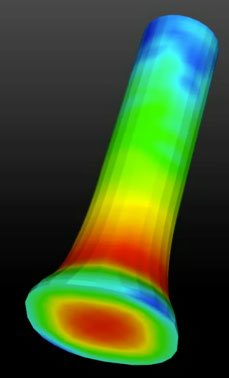Introduction¶

Fig. 1 Taylor Anvil Impact¶
FleCSI is a compile-time configurable framework designed to support multi-physics application development. As such, FleCSI provides a very general set of infrastructure design patterns that can be specialized and extended to suit the needs of a broad variety of solver and data requirements. FleCSI currently supports multi-dimensional mesh topology, geometry, and adjacency information, as well as n-dimensional hashed-tree data structures, graph partitioning interfaces, and dependency closures.
FleCSI introduces a functional programming model with control, execution, and data abstractions that are consistent both with MPI and with state-of-the-art, task-based runtimes such as Legion and Charm++. The abstraction layer insulates developers from the underlying runtime, while allowing support for multiple runtime systems including conventional models like asynchronous MPI.
The intent is to provide developers with a concrete set of user-friendly programming tools that can be used now, while allowing flexibility in choosing runtime implementations and optimizations that can be applied to future architectures and runtimes.
FleCSI’s control and execution models provide formal nomenclature for describing poorly understood concepts such as kernels and tasks. FleCSI’s data model provides a low-buy-in approach that makes it an attractive option for many application projects, as developers are not locked into particular layouts or data structure representations.
Contents:
- Overview
- Build & Install
- Tutorial
- User Guide
- Developer Guide
- API Reference
- Contributors


